Family Name: Combretaceae R. Brown
Synonym(s): Bucidaceae Spreng.; Myrobalanaceae Martinov; Strephonemataceae Venkat. & Prak. Rao, nom. inval.; Terminaliaceae J. St.-Hil.
Common Name(s): amaranth family
*Number of genera/species: 10/530
List of genera records in GRIN-Global
Fruit indehiscentindehiscent:
not opening on its own, as in a fruit
 , drupedrupe:
, drupedrupe:
(indehiscent drupe) a fleshy, indehiscent fruit with one more hard pits enclosing seeds; (dehiscent drupe) a fruit with a dry or fibrous to fleshy or leathery outer husk that early to tardily breaks apart (or opens), exposing one or more nutlike pits enclosing the seeds
 , acheneachene:
, acheneachene:
a dry, indehiscent, one-seeded fruit, with seed attached to pericarp at a single point , or samarasamara:
, or samarasamara:
a winged, indehiscent, dry fruit containing a single (rarely two) seed(s)
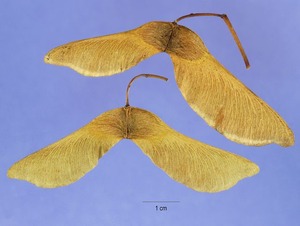 , (technically a pseudocarp as the outer layer is derived from the hypanthium, except in Strephonema, which is derived from a semi-inferior ovary and only the base is hypanthial tissue), 5–100 mm, rarely to 130 mm, globoseglobose:
, (technically a pseudocarp as the outer layer is derived from the hypanthium, except in Strephonema, which is derived from a semi-inferior ovary and only the base is hypanthial tissue), 5–100 mm, rarely to 130 mm, globoseglobose:
3D shape—more or less spherical to rhomboid, tereteterete:
to rhomboid, tereteterete:
approximately circular in cross section; width and thickness approximately equal
 , star-shapedstar-shaped:
, star-shapedstar-shaped:
(of fruit), having a distal aspect like the stylized shape of a star, usually found in aggregate versus simple fruit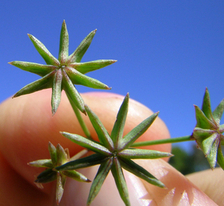 , rectangular, flattened, compressedcompressed:
, rectangular, flattened, compressedcompressed:
flattened; in grasses, used to denote compression (not necessarily flattened) either laterally or dorsiventrally
on one-side in transectiontransection:
a cross section; representing a plane made by cutting across an organ at a right angle to its length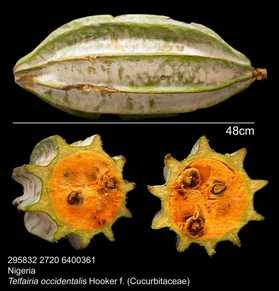 , often beakedbeak:
, often beakedbeak:
a usually firm, terminal appendage, sometimes tapered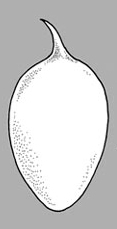 , usually 2–5 winged, longitudinally or rarely encircling seed body, if not winged then often ribbedribbed:
, usually 2–5 winged, longitudinally or rarely encircling seed body, if not winged then often ribbedribbed:
surface relief—wide, prominent, linear ridges that are generally rounded and longitudinally situated on the surface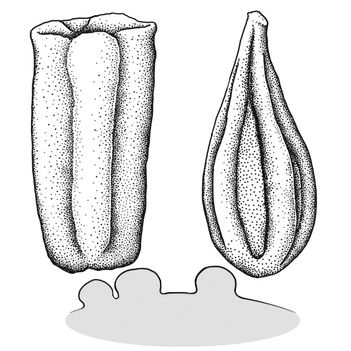 or ridgedridged:
or ridgedridged:
surface relief—raised, thick ridges, sharp edged or rounded, usually in a series that may cover the entire surface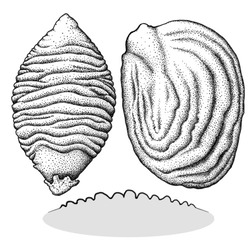 , 1-seeded, often with persistent calyxcalyx:
, 1-seeded, often with persistent calyxcalyx:
the outer whorl of the perianth; all the sepals of a flower
 and/or stylestyle:
and/or stylestyle:
in a flower, the narrow and elongated part of the pistil between the stigma and the ovary; sometimes persisting in fruit
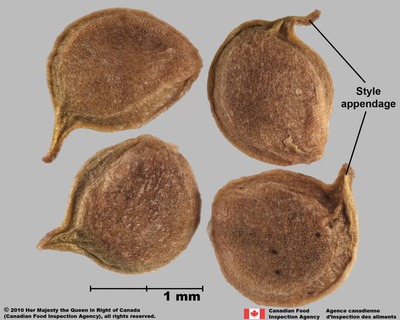 . Pericarppericarp:
. Pericarppericarp:
fruit wall or fruit coat
variously colored, dulldull:
reflecting only a low proportion of incident light, with no apparent sheen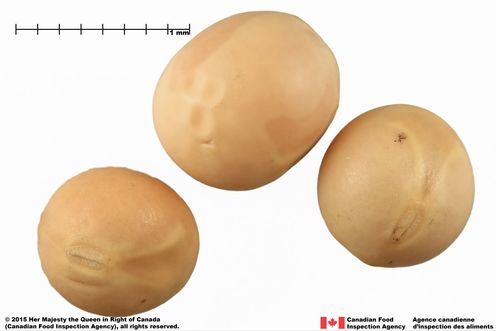 or shinyshiny:
or shinyshiny:
uniformly reflecting a high proportion of incident light at all angles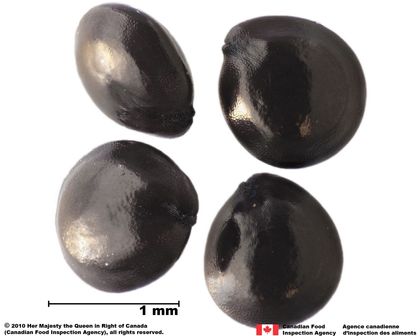 , woodywoody:
, woodywoody:
texture—consisting mainly of indurate lignified tissues, characteristic of or resembling wood
, corkycorky:
firm, relatively light, discontinuous but strongly cohesive, and resilient
, leatheryleathery:
texture—moderately thick, tough, and very pliable
, paperypapery:
texture—papyraceous, chartaceous; very thin, pliable, and readily torn; like paper
or fleshyfleshy:
texture—fairly firm and dense, juicy or at least moist, and easily cut
, glabrousglabrous:
without hairs
or pubescentpubescent:
surface relief—bearing hairs
, often with white, yellow or red scales, sometimes wrinkledwrinkled:
surface relief—shallow, irregular folds and furrows covering the surface; appearing overall though crumpled and then spread out , striatestriate:
, striatestriate:
surface relief—having fine, parallel lines, grooves or ridges , or veiny, rarely with hornshorn:
, or veiny, rarely with hornshorn:
a straight or curved, slenderly conic or conoidal protrusion, resembling an animal horn
or tubercles.
In several genera wings are derived from accrescentaccrescent:
growing continuously
calyces, Calycopteris, or from prophylls, Dansiea and Macropteranthes. In Conocarpus, drupes or nutletsnutlet:
˜achene
densely clustered into a head.
Seed globoseglobose:
3D shape—more or less spherical , fusiformfusiform:
, fusiformfusiform:
spindle-shaped; broadest at the middle and tapering at both ends
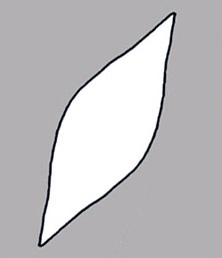 or angularangular:
or angularangular:
2D shape—having sides that meet at acute or obtuse angles
, 2–40 mm long. Seed coat brown, membranousmembranous:
texture—extremely thin, pliable, and fairly tough
, glabrousglabrous:
without hairs
, ribbedribbed:
surface relief—wide, prominent, linear ridges that are generally rounded and longitudinally situated on the surface , lobed, striatestriate:
, lobed, striatestriate:
surface relief—having fine, parallel lines, grooves or ridges , pittedpitted:
, pittedpitted:
surface relief—surface with small depressions in which the areas between the hollows do not take on the appearance of a true reticular net , reticulatereticulate:
, reticulatereticulate:
surface relief—netted, raised walls or concave grooves forming a net-like surface pattern with flat, concave, or convex interspaces , or wrinkledwrinkled:
, or wrinkledwrinkled:
surface relief—shallow, irregular folds and furrows covering the surface; appearing overall though crumpled and then spread out .
.
Embryo well developed, completely filling seed cavity, straight, sometimes green. Cotyledons usually 2 but if fused, may appear as 1 (Combretum spp.), or 3–5 in Terminalia spp. Cotyledons usually variously folded or spirally twisted, sometimes not folded, rarely massive and conduplicate (Strephonema, Combretum spp.).
Endospermendosperm:
nutritive starch- and oil-containing tissue present in many seeds
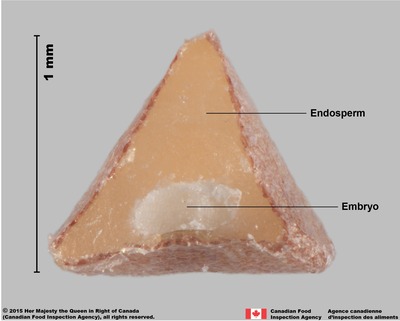 absent.
absent.
| Fruit | |
| Type | drupe, acheneachene: a dry, indehiscent, one-seeded fruit, with seed attached to pericarp at a single point  , samara , samara |
| Size range | 5–100 mm long, rarely to 130 mm |
| Shape(s) | globose, ellipsoidellipsoid: 3D shape—elliptic , fusiformfusiform: spindle-shaped; broadest at the middle and tapering at both ends  , ovoidovoid: , ovoidovoid:3D shape—ovate  , obovoidobovoid: , obovoidobovoid:3D shape—obovate , cylindricalcylindrical: 3D shape—a cylinder, with parallel sides and a circular cross-section; tubular or rod-shaped , pyriform, rhomboid, sometimes short stipitate |
| Texture | woody, corkycorky: firm, relatively light, discontinuous but strongly cohesive, and resilient , leatheryleathery: texture—moderately thick, tough, and very pliable , paperypapery: texture—papyraceous, chartaceous; very thin, pliable, and readily torn; like paper , fleshy |
| Surface relief | usually 2–5 winged, ribbedribbed: surface relief—wide, prominent, linear ridges that are generally rounded and longitudinally situated on the surface  or lobed, glabrousglabrous: or lobed, glabrousglabrous:without hairs or pubescentpubescent: surface relief—bearing hairs , sometimes with white, yellow, or red scales (lepidote) |
| Color(s) | black, purple, blue, green, brown, yellow, vivid pink or pink, red |
| Unique features | Usually winged or ribbedribbed: surface relief—wide, prominent, linear ridges that are generally rounded and longitudinally situated on the surface  drupesdrupe: drupesdrupe:(indehiscent drupe) a fleshy, indehiscent fruit with one more hard pits enclosing seeds; (dehiscent drupe) a fruit with a dry or fibrous to fleshy or leathery outer husk that early to tardily breaks apart (or opens), exposing one or more nutlike pits enclosing the seeds  , achenesachene: , achenesachene:a dry, indehiscent, one-seeded fruit, with seed attached to pericarp at a single point  , or samarassamara: , or samarassamara:a winged, indehiscent, dry fruit containing a single (rarely two) seed(s)  often with persistent calyxcalyx: often with persistent calyxcalyx:the outer whorl of the perianth; all the sepals of a flower  and/or stylestyle: and/or stylestyle:in a flower, the narrow and elongated part of the pistil between the stigma and the ovary; sometimes persisting in fruit  at apexapex: at apexapex:the point farthest from the point of attachment, or the "tip" of an organ 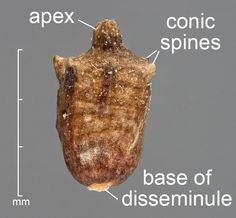 enclosing a solitary seed completely filledfilled: enclosing a solitary seed completely filledfilled:(of embryo) embryo fills the seed interior with the food reserves stored in the cotyledons; small amounts of endosperm may remain around the embryo  by the embryo.. by the embryo.. |
| Seed | |
| Size range | 2–40 mm long |
| Shape(s) | globose, fusiformfusiform: spindle-shaped; broadest at the middle and tapering at both ends  , angular , angular |
| Surface relief | smooth, ribbedribbed: surface relief—wide, prominent, linear ridges that are generally rounded and longitudinally situated on the surface  , ridged , ridged |
| Color(s) | brown |
| Unique features | Seeds, rarely disseminulesdisseminule: detachable plant part capable of being disseminated and of propagating, commonly a seed or fruit , without endospermendosperm: nutritive starch- and oil-containing tissue present in many seeds  , and seed cavity completely filledfilled: , and seed cavity completely filledfilled:(of embryo) embryo fills the seed interior with the food reserves stored in the cotyledons; small amounts of endosperm may remain around the embryo  with the embryo. with the embryo. |
| Other | |
| Embryo | well developed, completely filling seed cavity, straight, sometimes green. Cotyledons usually 2 but if fused, may appear as 1 (Combretum spp.), or 3–5 in Terminalia spp. Cotyledons usually variously folded or spirally twisted, sometimes not folded, rarely massive and conduplicate (Strephonema, Combretum spp.). |
| Nutritive tissuenutritive tissue: tissue within the seeds that nourishes the developing embryo; such as endosperm, perisperm, or chalazosperm in angiosperms; megagametophyte in gymnosperms |
endosperm endosperm: nutritive starch- and oil-containing tissue present in many seeds  absent absent |
Pantropical
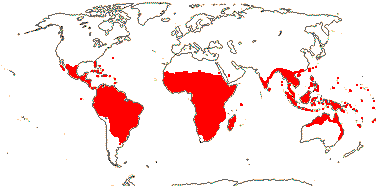
Distribution map courtesy of Angiosperm Phylogeny Website.
Davidse et al. 2009–2018Davidse et al. 2009–2018:
Davidse GM, Sousa Sánchez M, Knapp S. and Chiang Cabrera F, eds. 2009–2018. Flora Mesoamericana. Missouri Botanical Garden, St. Louis, MO. Accessed: January–April 2024. URL: http://legacy.tropicos.org/Project/FM; Flora of Australia 2021+Flora of Australia 2021+:
Flora of Australia. Australian Biological Resources Study, Canberra. Accessed January 2021–March 2024. URL: http://www.ausflora.org.au; Flora of North America Editorial Committee 1993+Flora of North America Editorial Committee 1993+:
Flora of North America Editorial Committee, eds. 1993+. Flora of North America North of Mexico [Online]. 22+ vols. Flora of North America Association, New York and Oxford. Accessed January-March 2024. URL: http://beta.floranorthamerica.org.; Hutchinson and Dalziel 1954–1972Hutchinson and Dalziel 1954–1972:
Hutchinson J and Dalziel JM, revised by Keay RWJ and Hepper FN. 1954–1972. Flora of West Tropical Africa, ed. 2, 3 Vols. 2300 pp.; Liben 1968Liben 1968:
Liben L. 1968. Combretaceae. In : Flore du Congo, du Rwanda et du Burundi, Spermatophytes. Bruxelles, Jardin botanique national de Belgique. [version PDF, 10.5281/zenodo.4514585] Kirkbride et al. 2006Kirkbride et al. 2006:
Kirkbride JH, Jr, Gunn CR, and Dallwitz MJ. 2006. Family guide for fruits and seeds, vers. 1.0. Accessed September 2020-January 2022. URL: https://nt.ars-grin.gov/seedsfruits/keys/frsdfam/index.cfm .; Kubitzki et al. 1990+Kubitzki et al. 1990+:
Kubitzki K et al., eds. 1990+. The families and genera of vascular plants. 7+ vols. Berlin etc.; Takhtajan 2009Takhtajan 2009:
Takhtajan A. 2009. Flowering plants: Second edition. Springer Nature, Switzerland. 871 pp.; Tomlinson 2016; Zhengyi et al. 2004+Zhengyi et al. 2004+:
Zhengyi W, Raven PH, and Deyuan H. 2004+. Flora of China [online]. 25 vols. Science Press, Beijing China & Missouri Botanical Garden, St. Louis USA. Accessed January–March 2024. http://flora.huh.harvard.edu/china/
*The number of genera and species is based on Christenhusz and Byng 2016Christenhusz and Byng 2016:
Christenhusz MJM and Byng JW. 2016. The number of known plant species in the world and its annual increase. Phytotaxa 261 (3): 201-217. https://doi.org/10.11646/phytotaxa.261.3.1, which may differ from the number of genera in GRIN-Global.